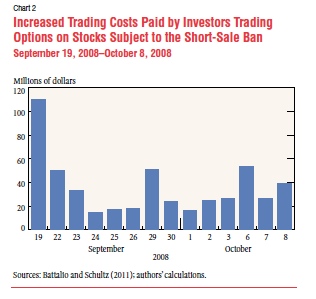The short selling ban imposed on the markets by the Securities and Exchange Commission during the financial crisis of 2008 cost options traders $500 million.
At the same time, the ban did nothing to halt the decline in the prices of financial stocks. That’s according to a new study by the Federal Reserve Bank of New York.
“Even with the bans in place, prices continued to fall,” the authors of the study write in the Fed’s Current Issues publication. Plus, “the ban lowered market liquidity and increased trading costs.”
The report was authored by Robert Battalio and Paul Schultz, finance professors at the University of Notre Dame, and Hamid Mehran, an assistant vice president in the New York Fed’s statistics group.
They found that bid-ask spreads for options on the financial stocks subject to the short sale ban widened significantly during the period. Between September 19, 2008, and October 8, 2008, the period of the ban, spreads were 10 percent on average wider than those of a group of options on non-financial stocks.
Over the course of the 14-day period, the wider spreads cost options traders about $500 million, according to the study. Although options market makers were exempt from the ban, there was enough uncertainty surrounding the temporary rules that they chose to quote less aggressively, according to the study’s authors.
Options market makers typically hedge their positions by selling stock short. When the ban was first announced, dealers threatened not to quote unless they were given an exemption.





